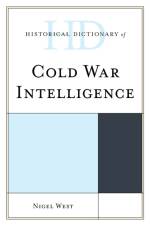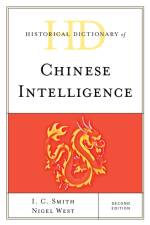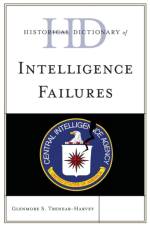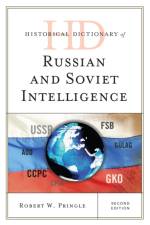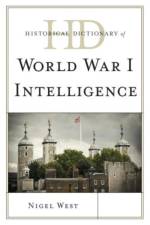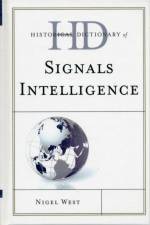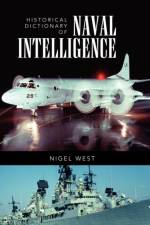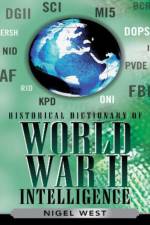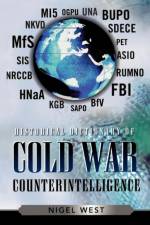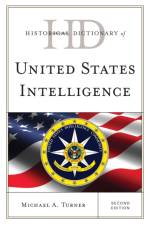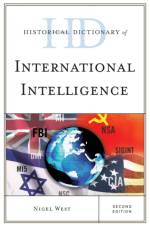Bøger i Historical Dictionaries of Intelligence and Counterintelligence serien
-
1.293,95 kr. From the moment man learned how to ascend off the ground, the strategic significance of air intelligence became apparent. This relatively new discipline_the first dedicated air reconnaissance missions were undertaken in 1870 during the siege of Paris when tethered French balloons were employed to spot enemy positions and direct artillery fire onto them_has developed at an astonishing speed. Over the past century air intelligence has moved from hazardous observation balloons to micro-circuitry, which can send pictures from a video camera mounted on a remotely-controlled vehicle the size of a hummingbird. The Historical Dictionary of Air Intelligence relates the evolving history of the rapidly advancing field of air intelligence. A chronology, an introductory essay, and cross-referenced dictionary entries on the agencies, agents, operations, equipment, tradecraft, and jargon of air intelligence make this reference as essential as it is fascinating.
- Bog
- 1.293,95 kr.
-
1.764,95 kr. This Historical Dictionary of Cold War Intelligence contains a chronology, an introduction, and an extensive bibliography. The dictionary section has hundreds of cross-referenced dictionary entries on crucial operations spies, defectors, moles, double and triple agents, and the tradecraft they apply.
- Bog
- 1.764,95 kr.
-
1.100,95 kr. The second edition of Historical Dictionary of Chinese Intelligence covers the history of Chinese Intelligence from 400 B.C. to modern times. The dictionary section has over 400 cross-referenced entries on the agencies and agents, the operations and equipment, the tradecraft and jargon, and many of the countries involved.
- Bog
- 1.100,95 kr.
-
1.087,95 kr. Almost from the moment in 1940 that Otto Frisch and Rudofl Peierls suggested, from their small office in the University of Birmingham, that an atomic weapon could be miniaturized and delivered to its target by aircraft, the concept of atomic espionage can be said to have existed. No sooner had the famous Frisch-Peierls Memorandum been received by the British War Cabinet than a Soviet mole, John Cairncross, passed the details on to his Soviet contact. And 70 years later with the International Atomic Energy Authority (IAEA) estimating that up to 40 countries now have the capability of building nuclear weapons, the need to monitor this activity remains crucial.The Historical Dictionary of Atomic Espionage relates the history of atomic espionage through a chronology, an introductory essay, and cross-referenced dictionary entries on the agencies, agents, and operations. This book is an excellent access point for students, researchers, and anyone wanting to know more about atomic espionage.
- Bog
- 1.087,95 kr.
-
1.259,95 kr. The Historical Dictionary of Intelligence Failures covers the history of intelligence failures through a chronology, an introductory essay, an extensive bibliography, and over 100 cross-referenced dictionary entries on such topics as the Six Day War, the Cuban Missile Crisis, and 9/11.
- Bog
- 1.259,95 kr.
-
1.454,95 kr. This historical dictionary is the only volume that lays out how Russian and Soviet intelligence works and how its operations have impacted Russian history. It covers Russian intelligence from the imperial period to the present focusing in greatest detail on Cold War espionage cases and the Putin-era intelligence community.
- Bog
- 1.454,95 kr.
-
1.580,95 kr. Known as ';the Great War,' the world's first truly global conflict is remarkable in what might now be termed modern espionage. World War I was witness to plenty of 'firsts.' Apart from the contribution made by aerial reconnaissance and the interception of wireless telegraphy, telephone and cable traffic, there was the scientific aspect, with new machines of war, such as the submarine, sea-mine, torpedo, airship, barbed wire, armored tank and mechanized cavalry in a military environment that included mustard gas, static trench warfare, the indiscriminate bombardment of civilian population centers and air-raids. Large-scale sabotage and propaganda, the manipulation of news and of radio broadcasts, and censorship, were all features of a new method of engaging in combat, and some ingenious techniques were developed to exploit the movement of motor and rail transport, and the transmission of wireless signals. The hitherto unknown disciplines of train-watching, bridge-watching, airborne reconnaissance and radio interception would become established as routine collection methods, and their impact on the conflict would prove to be profound. The Historical Dictionary of World War I Intelligence relates this history through a chronology, an introductory essay, an appendix, and an extensive bibliography. The dictionary section has over 400 hundred cross-referenced entries on intelligence organizations, the spies, and the major cases and events of World War I. This book is an excellent access point for students, researchers, and anyone wanting to know more about the world of intelligence in World War I.
- Bog
- 1.580,95 kr.
-
1.883,95 kr. British Intelligence is the oldest, most experienced organization of its kind in the world, the unseen hand behind so many world events, and glamorized by James Bond. Despite the change in role, from a global power controlling an Empire that covered much of the world, to a mere partner in the North Atlantic Treaty Organization (NATO) and the European Union, the country's famed security and intelligence apparatus continues largely intact, and recognized as ';punching above its weight.' Feared by the Soviets, admired and trusted by the Central Intelligence Agency (CIA), British Intelligence has provided the hidden dimension to the conduct of domestic and foreign policy, with the added mystique of Whitehall secrecy, a shroud that for years protected the identities of the shadowy figures who recruited the sources, broke the codes, and caught the spies.This second edition of Historical Dictionary of the British Intelligence covers the history through a chronology, an introductory essay, appendixes, and an extensive bibliography. The dictionary section has over 1,000 cross-referenced entries on specific operations, spies and their handlers, the moles and defectors, top leaders, and main organizations. This book is an excellent access point for students, researchers, and anyone wanting to know more about the British Intelligence.
- Bog
- 1.883,95 kr.
-
1.477,95 kr. Signals Intelligence (SIGINT) encompasses the various disciplines of wireless interception, cryptanalysis, communications intelligence, electronic intelligence, direction-finding, and traffic analysis. It has become the basis upon which all combat operations are undertaken. It is now widely recognized as an absolutely vital dimension to modern warfare and it has proved to be a vital component in the counter-intelligence war fought between the West and Soviet bloc intelligence agencies.The Historical Dictionary of Signals Intelligence covers the history of SIGINT through a chronology, an introductory essay, an appendix, and an extensive bibliography. The dictionary section has over 300 cross-referenced entries on key personnel, SIGINT technology, intelligence operations, and agencies, as well as the tradecraft and jargon. This book is an excellent access point for students, researchers, and anyone wanting to know more about Signals Intelligence.
- Bog
- 1.477,95 kr.
-
1.477,95 kr. Naval intelligence is one of the most vital, and sometimes decisive, forms of intelligence. Over the centuries, and with particular velocity over recent decades, the techniques of detecting and destroying military (and commercial) shipping have improved, leapfrogging the equally frantic race to keep ahead of them and safeguard the huge investments involved. Today the new challenges range from an increasingly aggressive strategy adopted by Pyongyang's submarine fleet and the exclusion of illegal immigrants heading for Australia and southern Europe to the capture of cocaine-laded submarines in the Caribbean and the interdiction of Somali pirates off the Gulf of Aden. Any accurate assessment of the comparative threat these activities pose is just as dependent on good intelligence today as it was to Admiral Lord Nelson in the days of sail. The Historical Dictionary of Naval Intelligence relates the long and fascinating history of naval intelligence through a chronology, an introduction, a bibliography, and hundreds of cross-referenced dictionary entries on the organizations, operations, and events that made Naval intelligence what it is today.
- Bog
- 1.477,95 kr.
-
1.408,95 kr. Given the rivalries and suspicions prevailing in the Middle East, it is not surprising that most of these states are very concerned about espionage and infiltration. With the additional threat of terrorism, nuclear weapons, a large U.S. military presence, and the Arab-Israeli conflict, the result is an impressively busy intelligence industry, proportionately larger and more extensive than in most other regions. The Historical Dictionary of Middle East Intelligence addresses intelligence issues in the region from ancient history and the Middle Ages through modern times, covering the decline of the Ottoman Empire, intelligence activity in the Middle East during and between the two world wars, and the interplay between colonial and local intelligence and counterintelligence agencies of the period. It also presents the relatively new fundamentalist terrorist organizations that have had a significant impact on international relations and on the structure and deployment of intelligence, counterintelligence, and other security organs in the Middle East today. With a chronology, an introductory essay, and over 300 cross-referenced dictionary entries on important events and key organizations involved in all aspects of intelligence gathering and analysis, as well as the biographies of key players, this is an important reference on the current situation in the Middle East.
- Bog
- 1.408,95 kr.
-
1.295,95 kr. In the years immediately following World War II, information was disclosed about what has been termed the shadow war of the existence of hitherto secret agencies. In Germany it was the Abwehr and the Sicherheitsdienst; in Britain it was MI5, the Secret Intelligence Service (MI6) and Special Operations Executive (SOE); in the United States it was the Office of Strategic Services (OSS) and the Special Intelligence Service (SIS) of the Federal Bureau of Investigation (FBI); in Japan it was the Kempetai; and in Italy the Servicio di Informazione Militare (SIM). Sixty years after World War II secrets are still being revealed about the covert activities that took place. Many countries had secret agencies maintaining covert operations, but even ostensibly neutral countries also conducted secret operations. Changes in American, British, and even Soviet official attitudes to declassification in the 1980s allowed thousands of secret documents to be made available for public examination, and the result was extensive revisionism of the conventional histories of the conflict, which previously had excluded references to secret intelligence sources.The Historical Dictionary of World War II Intelligence tells the emerging history of the intelligence world during World War II. This is done through a chronology, an introduction, a bibliography, and hundreds of cross-referenced dictionary entries on the secret agencies, operations, and events. The world of double agents, spies, and moles during WWII is explained in the most comprehensive reference currently available.
- Bog
- 1.295,95 kr.
-
1.936,95 kr. The defection of Igor Gouzenko in September 1945, more so than any other single event, alerted the West to the nature and scale of the Soviet espionage offensive being waged by the Kremlin. Apart from the dozen or so defendants convicted of spying, Gouzenko wrecked an organization that had taken years to develop, exposed the penetration of the Manhattan atomic weapons project, and demonstrated the very close relationship between the Canadian Communist Party and Moscow. Many credit this event as sparking the bitter but secretive struggle fought between the intelligence agencies of the East and West for nearly half a century. The Historical Dictionary of Cold War Counterintelligence tells the story of both sides' fierce efforts to penetrate and subvert the opponent while desperately trying to avoid a similar fate. Through a chronology, an introduction, appendixes, a bibliography, and hundreds of cross-referenced dictionary entries on the organizations, operations, events, and personalities that influenced counterintelligence during the Cold War, the world of double agents, spies, and moles is explained in the most comprehensive reference currently available.
- Bog
- 1.936,95 kr.
-
1.855,95 kr. No country can rival the sheer diversity of intelligence organizations that Germany has experienced over the past 300 years. Given its pivotal geographical and political position in Europe, Germany was a magnet for foreign intelligence operatives, especially during the Cold War. As a result of this, it is no wonder that during certain periods of history Germany was probably busier spying on its own citizens than on its enemies. Because of the Gestapo and the SS of Nazi Germany to the Stasi of the German Democratic Republic, the fear of domestic abuse by security agencies with police powers runs far deeper in German society than elsewhere in the West. The Historical Dictionary of German Intelligence presents the turbulent history of German intelligence through a chronology, a bibliography, and hundreds of cross-referenced dictionary entries on the agencies and agents, the operations and equipment, the tradecraft and jargon, and many of the countries involved. No military reference collection is complete without it.
- Bog
- 1.855,95 kr.
-
- Fact and Fiction
1.225,95 kr. Twelve novels and nine short stories define one of the most extraordinary fictional characters of all time, creating the basis for the most successful movie series in cinematographic history, watched by more than half the world's population. The single person probably more responsible than any other for glamorizing the murky world of espionage is Ian Fleming, the creator of James Bond, who himself lived a remarkable double life of spy and writer. Everyone has an opinion on why 007 became so successful, but one possible explanation is the ingenious formula of fact, fiction, and sheer fantasy. Certainly the author drew on friends and places he knew well to provide the backdrop for his drama, but what proportion of his output is authentic, and what comes directly from the author's imagination? These questions and more are examined in the Historical Dictionary of Ian FlemingOs World of Intelligence: Fact and Fiction. This is done through a chronology, an introduction, a bibliography, and hundreds of cross-referenced dictionary entries on actual cases of espionage, real-life spies, MI5, SIS, CIA, KGB, and others. It also contains entries on Ian Fleming's novels and short stories, family and friends, his employers and colleagues, and other notable characters.
- Bog
- 1.225,95 kr.
-
1.259,95 kr. This second edition covers the history of United States intelligence, and includes several key features: *Chronology *Introductory essay*Appendixes*Bibliography*Over 600 cross-referenced entries on key events, issues, people, operations, laws, regulations
- Bog
- 1.259,95 kr.
-
1.523,95 kr. This second edition of Historical Dictionary of International Intelligence covers its history through a chronology, an introductory essay, and an extensive bibliography. This book is an excellent access point for students, researchers, and anyone wanting to know more about the international intelligence.
- Bog
- 1.523,95 kr.


